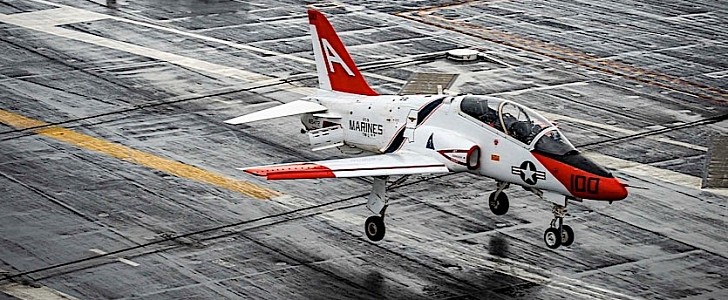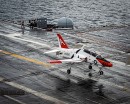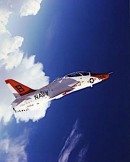In the auto industry, when a potentially dangerous fault is discovered, carmakers issue recalls. Most often than not, these recalls take a very long time to complete, and drivers are not generally prevented from using their vehicles in the meantime.
When it comes to aviation, including the military one, things are a lot more serious though. When a fault is discovered, aircraft are grounded, often entire fleets of them. At the beginning of September, for instance, the U.S. Army grounded its entire fleet of CH-47 Chinooks on account of fuel leak fires.
This week, the U.S. Navy followed suit, declaring a “safety pause” for its fleet of T-45C Goshawks. The reason for this is the discovery of an engine blade failure, but no additional details have been provided.
The Goshawk is a training jet, based on the BAE Systems Hawk. The two-seater entered service with the American military branches (Navy and Marine Corps) in 1991 (T-45A), replacing the T-2C Buckeye and the TA-4J Skyhawk.
There were two versions of the plane made, the T-45A with an analog cockpit and the T-45C with a digital one. Both are powered by Rolls Royce turbofan engines (a single one per plane) capable of developing 5,527 pounds of thrust.
With this powerplant, the Goshawks are capable of reaching speeds of 645 mph (1,038 kph) and can fly as high as 42,500 feet (12,954 meters). The range of the plane is rated at 805 miles (1,288 km).
Although it did not disclose the nature of the failure, the U.S. Navy said it is “working around the clock with industry partner Rolls-Royce to identify the root cause of the recent T-45 engine blade failure.“
No mention was made as to how long the pause will last. There were over 200 such planes built over the years, but it’s unclear how many of them are still in service.
This week, the U.S. Navy followed suit, declaring a “safety pause” for its fleet of T-45C Goshawks. The reason for this is the discovery of an engine blade failure, but no additional details have been provided.
The Goshawk is a training jet, based on the BAE Systems Hawk. The two-seater entered service with the American military branches (Navy and Marine Corps) in 1991 (T-45A), replacing the T-2C Buckeye and the TA-4J Skyhawk.
There were two versions of the plane made, the T-45A with an analog cockpit and the T-45C with a digital one. Both are powered by Rolls Royce turbofan engines (a single one per plane) capable of developing 5,527 pounds of thrust.
With this powerplant, the Goshawks are capable of reaching speeds of 645 mph (1,038 kph) and can fly as high as 42,500 feet (12,954 meters). The range of the plane is rated at 805 miles (1,288 km).
Although it did not disclose the nature of the failure, the U.S. Navy said it is “working around the clock with industry partner Rolls-Royce to identify the root cause of the recent T-45 engine blade failure.“
No mention was made as to how long the pause will last. There were over 200 such planes built over the years, but it’s unclear how many of them are still in service.





